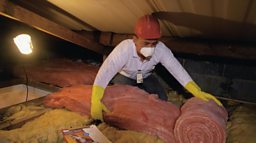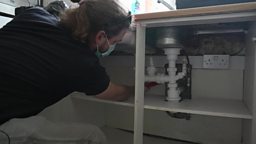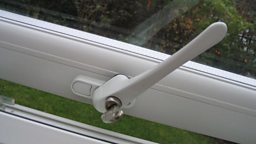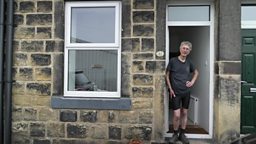Seven ways to make your home more energy efficient
Most people probably don’t think that much about the way we heat our homes contributing to climate change. But millions of houses in the UK are poorly insulated and, along with the gas we use for heating, hot water and cooking, it is creating around , according to latest figures from the Department of Business, Energy and Industrial Strategy.
New-builds are generally more energy efficient, but most of the UK’s existing structures will need retrofitting with insulation or different heating systems to make them fit for the future.

Dr David Glew is Head of Energy Efficiency and Policy at Leeds Beckett University. He’s been conducting experiments at a test house, where his team takes measurements to see if their changes have made the building more energy efficient.
“We’re interested in how much energy we can save in our homes. We’re installing common things that many people might think about, and then testing them to see if they can save as much money and energy as the Government models predict.
“There’s some great “low-hanging fruit” for retro-fitting, which you can do
1. Get high

Go to the top of your house. If you only have one day to look at energy improvements, you can go into your loft and check out the insulation up there.
Ideally we’re looking for two layers of insulation: one between the joists, and one over the top. You can get the materials from any DIY store.
2. Clear out

While you’re up there, have a de-clutter. One of the big problems with loft insulation is that often there’s stuff on top of it, so get rid of it as it is reducing the benefit of the insulation.
Bin bags full of clothes or old toys can sit on top of the material, compressing it and making it less useful for us. It’s a great opportunity for a spring clean.
3. More insulation

If you think about your house like a box, you can insulate the loft, which is the top; the walls, which are the sides; you can insulate the floor and you can seal up the edges. The savings you can get depend on the size and shape of the house, and every single one is different.
There are different types of wall insulation depending on the way the house is constructed (either cavity wall or solid wall), whereas floor insulation tends to be the costliest of the options.
4. Mind the gap

The thing people often miss is the draughts; a lot of our homes aren’t very air-tight. If you can seal up draughts, you can save energy. Think about it like a warm coat, it’s not as effective if you haven’t zipped it up.
There are two types of air movement through our homes: one is good and keeps us healthy; and one is bad, which is what we want to get rid of. The good ventilation includes trickle vents on windows, which should stay open. The bad ventilation includes holes and gaps where pipes and cables go through the walls. Go under your sink and have a look if your waste pipe has gaps around it – if it does then these can be sealed up.
5. New windows and doors

This is a common retrofit. In our test house this reduced heat loss by around 5 percent, but it already had quite decent double glazing to begin with. If this house previously had single glazed windows, the savings would have been higher.
6. Take control

Don’t waste heat, don’t overheat rooms or heat rooms that you don’t use. Learn how to set the controls on your heating system so that you can turn the heating on and off, meaning energy isn’t being used when it’s not needed.
7. Knowledge is power

Every home that’s built, sold or rented needs to have an Energy Performance Certificate, known as an EPC. This contains information about a property’s energy use and typical energy costs, and is rated from A for the most efficient to G for the least efficient. Check the property’s EPC, because only 40 percent of homes are rated C or above.
Properties that are rented out legally need to be rated E or above, rising to C by 2035. Anyone can look up the EPC of any house online from the Government’s EPC database, so renters can check their own EPCs and ask their landlord to take action if the property falls below minimum standards.
'The bills have gone through the floor'

Rod Holt describes himself as a long-time resident of Otley with a passion for cycling. He also spends a lot of his time researching ways to make his home greener and more comfortable.
Since buying the mid-terraced house in 1982, he’s installed his own roof and loft insulation, draft-proofing, triple-glazed windows and an air-source heat pump.
“The bills have gone through the floor, and the solar panels I have on the roof pretty-much cover the energy I use during the year," he said.
"Because I got in on the PV (photovoltaic) bandwagon at an early stage, I get paid a good rate for the energy I generate. That’s allowed me to fund other improvements to the house.
"I didn’t want to spend the last few years of my life like my father did, freezing. It’s never cold in here, even when I’ve been away for a few days in the winter."
One of the few jobs he had to get a professional to do was put in the air conditioning system.
"The trouble with insulation and draft-proofing though is that you can run into problems with ventilation and moisture in the air. It’s important to use mechanical ventilation to make sure you’re getting fresh air into the house. The system I’ve gone for is heat recovery, so the air going out of the house gives up its heat to the fresh air coming in," he said.
Rod’s interest in helping the environment has increased since becoming a grandfather.
“I’ve now got a grand-daughter less than a year old. She’s going to grow up in this world that we’re leaving behind for her. It’s a matter of my personal integrity that my part of that world is no worse than how I found it," he said.
See more climate change stories from 5 Live
-
![]()
'My food waste is embarrassing'
Four dads in Leeds try cutting down on their family's food waste.
-
![]()
Tips for a planet-friendly breakfast
5 Live challenges former Master Chef finalist Anthony O'Shaughnessy to make a lower-carbon fry-up.
-
![]()
Uniform exchange 'a massive financial help'
A mum says how a scheme to recycle school uniform has helped her save hundreds of pounds a year.



